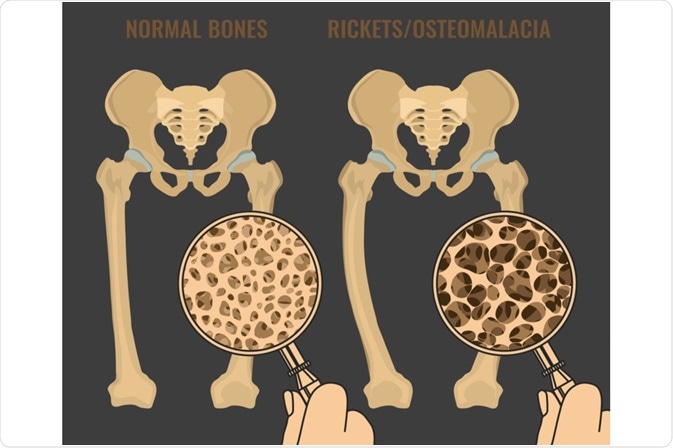Rickets is a disease of the growing bones, characterized by defective mineralization of the osseous matrix and epiphyseal cartilage, which stems from a lack of calcium and phosphorous metabolism. The condition is traditionally caused by a quantitative or qualitative lack of vitamin D.
Rickets is the disease of a growing organism; hence, the clinical findings and deformities are more specific to the bone tissue that is undergoing rapid growth at the age of onset. Thorough medical history, careful physical examination, and adequate interpretation of laboratory and radiographic findings are pivotal steps for establishing a correct diagnosis.

Image Credit: Double Brain / Shutterstock.com
Medical history
Information about the infant's or child's age, diet, the extent of sunlight exposure, and geography of residence should be obtained. A detailed dietary history should encompass specifics of vitamin D and calcium intake. Furthermore, a history of low stature in the family, alopecia, orthopedic abnormalities, and consanguineous marriage should be investigated for differential diagnosis.
When doing a review of systems, the physician's focus should be on growth and orthopedic concerns, as well as on signs and symptoms of hypocalcemia. Some of the principal signs of hypocalcemia that the physician should take note of include muscle cramps, tetany, paresthesias, and seizures. Secondary to hypocalcemia, children may also report that they experience carpopedal spasms.
Physical examination
As rickets is characterized by delayed growth, bone and teeth deformities, as well as the occurrence of pain, complete physical and dental examinations should be performed. The whole skeletal system should be palpated in search of tenderness and skeletal deformities, with an active search for neurologic abnormalities.
Bone deformities of the forearms and posterior bowing of the distal tibia can be observed in infants, while toddlers who have started walking exhibit pronounced physiological bowing of the legs, which is a condition that is also known as genu varum. Older children may have valgus or “windswept deformity” in the legs.
Rickets, Causes, Signs and Symptoms, Diagnosis and Treatment.
Laboratory and radiographic features
When resources are available, laboratory and imaging techniques should be used for confirming the diagnosis and etiology of the disease. Radiology is not only a diagnostic tool but can also reveal the degree of severity from bone softening to the different degrees of bone fraying and deformities.
The most common laboratory findings in nutritional rickets (i.e. due to vitamin D deficiency) are decreased levels of serum calcium, serum phosphorus, calcidiol, calcitriol, and urinary calcium, as well as increased levels of serum parathyroid hormone, alkaline phosphatase, and urinary phosphorus. If both serum inorganic phosphorus and parathyroid hormone levels are normal, the diagnosis of rickets is unlikely.
The earliest radiographic findings of rickets consist of slight axial widening at the growth plate, which is followed by a decrease in the density of the metaphyseal side of the growth plate. As the disease progresses, the widening of the growth plate increases, while the zone of provisional calcification becomes irregular.
These radiographic changes are best observed in the regions where the growth is the most active, such as the knees, proximal humeri, and wrists. Classic radiographic findings are fraying and widening of the metaphysis, widening of the distal physis, and angular deformities of the arm and leg bones.
References
Further Reading